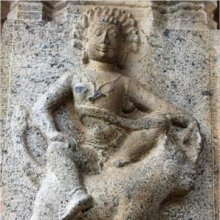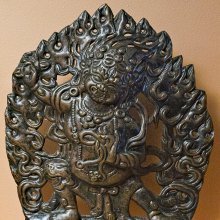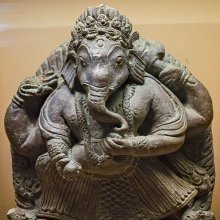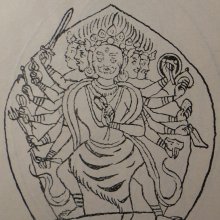Flame: 2 definitions
Introduction:
Flame means something in Hinduism, Sanskrit. If you want to know the exact meaning, history, etymology or English translation of this term then check out the descriptions on this page. Add your comment or reference to a book if you want to contribute to this summary article.
Images (photo gallery)
(+14 more images available)
In Hinduism
Shilpashastra (iconography)
Source: Shodhganga: Elements of Art and Architecture in the Trtiyakhanda of the Visnudharmottarapurana (shilpa)Flames are associated with Agni, whose iconography is described in the Viṣṇudharmottarapurāṇa, an ancient Sanskrit text which (being encyclopedic in nature) deals with a variety of cultural topics such as arts, architecture, music, grammar and astronomy.—According to the Viṣṇudharmottarapurāṇa, the image of Agni has four heads and four teeth. But the Kāśyapaśilpa says that the image of Agni should have four hands in the right side and three hands in the left side. The Viṣṇudharmottarapurāṇa opines to decorate the image of Agni with the garland of flames where as the Śilparatna instructs to decorate it with the garland of gold. Thus it is clear that the Viṣṇudharmottarapurāṇa offers a great field of knowledge regarding the nuances of Indian art of Image making [e.g., flames] during 10th–11th century A.D.

Shilpashastra (शिल्पशास्त्र, śilpaśāstra) represents the ancient Indian science (shastra) of creative arts (shilpa) such as sculpture, iconography and painting. Closely related to Vastushastra (architecture), they often share the same literature.
Yoga (school of philosophy)
Source: ORA: Amanaska (king of all yogas): A Critical Edition and Annotated Translation by Jason BirchA Flame (of fire) is denoted by the Sanskrit term Śikhā, according to the Amanaska Yoga treatise dealing with meditation, absorption, yogic powers and liberation.—Accordingly, as Īśvara says to Vāmadeva: “[...] That which [the Yogin] sees is gradually extinguished even as he looks at it, and also what he smells as he smells it, what he tastes as he tastes it, the agreeable sounding sounds as he hears them and what he touches as he touches it, and so also in due course the mind, like a flame without fuel (nir-indhana-śikhā), of the true Yogin who has reached the domain of the reality of that state which is called Non-duality. [...]”.

Yoga is originally considered a branch of Hindu philosophy (astika), but both ancient and modern Yoga combine the physical, mental and spiritual. Yoga teaches various physical techniques also known as āsanas (postures), used for various purposes (eg., meditation, contemplation, relaxation).
See also (Relevant definitions)
Starts with: Flame azalea, Flame combretum, Flame creeper, Flame flower, Flame lily, Flame nettle, Flame of the forest, Flame of the woods, Flame tree, Flame vine, Flame-tree sumac, Garland of flames.
Ends with: Jungle flame, Nandi flame, Nile flame, Uganda flame, Yellow flame.
Full-text (+1168): Jvala, Arcis, Agnijvala, Agnishikha, Shikha, Shocis, Agni, Dipasikha, Ulka, Shikhishikha, Jvalamala, Hayana, Vakshi, Jvalaka, Sahasrashokas, Jvalagni, Jvalapatala, Adipita, Dipacci, Saptajihva.
Relevant text
Search found 297 books and stories containing Flame; (plurals include: Flames). You can also click to the full overview containing English textual excerpts. Below are direct links for the most relevant articles:
Yoga Vasistha [English], Volume 1-4 (by Vihari-Lala Mitra)
Chapter LXXV - Description of the final conflagration of the world < [Book VII - Nirvana prakarana part 2 (nirvana prakarana)]
Chapter XLIII - Burning of the city < [Book III - Utpatti khanda (utpatti khanda)]
Chapter CXLI - Description of the termination of a kalpa-period < [Book VII - Nirvana prakarana part 2 (nirvana prakarana)]
Tiruvaymoli (Thiruvaimozhi): English translation (by S. Satyamurthi Ayyangar)
Pasuram 2.1.9 < [Section 1 - First Tiruvaymoli (Vayum tirai)]
Pasuram 8.9.3 < [Section 9 - Ninth Tiruvaymoli (Karu manikka malai)]
Pasuram 4.4.3 < [Section 4 - Fourth Tiruvaymoli (Mannai iruntu tulavi)]
Vakyapadiya of Bhartrihari (by K. A. Subramania Iyer)
Verse 1.106 < [Book 1 - Brahma-kāṇḍa (or Āgama-samuccaya)]
Verse 1.117 < [Book 1 - Brahma-kāṇḍa (or Āgama-samuccaya)]
Verse 1.46 < [Book 1 - Brahma-kāṇḍa (or Āgama-samuccaya)]
The Tattvasangraha [with commentary] (by Ganganatha Jha)
Verse 2756-2758 < [Chapter 24b - Arguments against the reliability of the Veda (the Revealed Word)]
Verse 707 < [Chapter 12 - Examination of the Category of ‘Action’]
Verse 589 < [Chapter 10 - The Examination of the First Category—‘Substance’]
Lord Jhulelal: An Analytical Study (by Thakkar Harish Gopalji)
Part 6 - Concept of Akhand Jyot < [Chapter 4 - Analysis]
Part 2 - Lord Jhulelal's teachings to Ruler Mirkshah < [Chapter 4 - Analysis]
Part 8 - Seven sacred things < [Chapter 4 - Analysis]
Related products
(+6 more products available)











